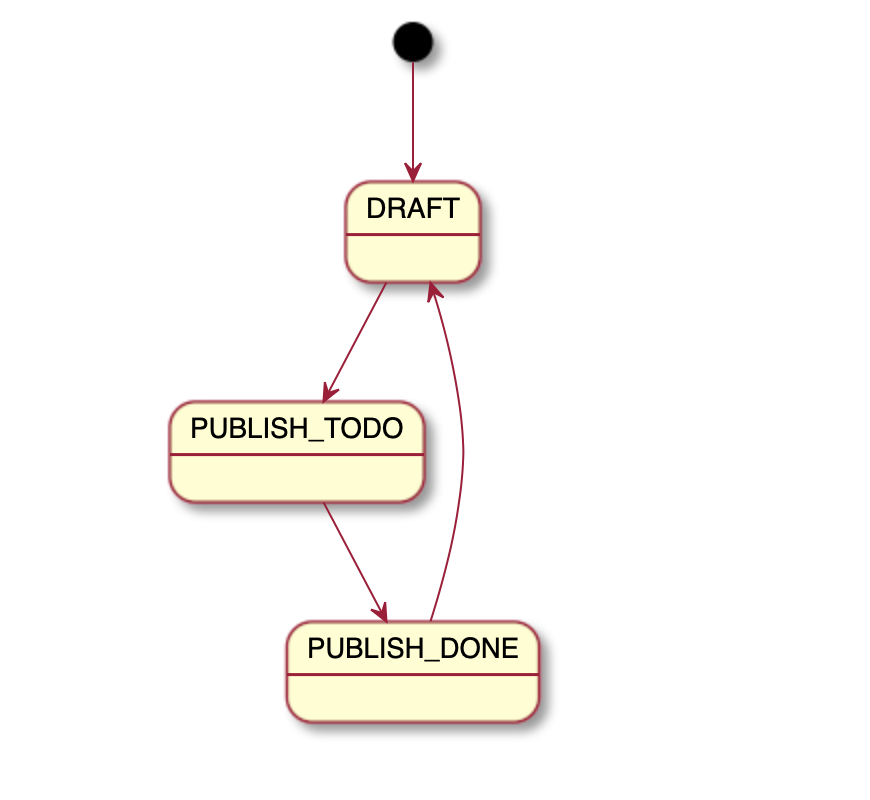Spring Boot 2.x實戰之StateMachine
- 2019 年 11 月 11 日
- 筆記
本文首發於個人網站:Spring Boot 2.x實戰之StateMachine
Spring StateMachine是一個狀態機框架,在Spring框架項目中,開發者可以通過簡單的配置就能獲得一個業務狀態機,而不需要自己去管理狀態機的定義、初始化等過程。今天這篇文章,我們通過一個案例學習下Spring StateMachine框架的用法。
案例介紹
假設在一個業務系統中,有這樣一個對象,它有三個狀態:草稿、待發佈、發佈完成,針對這三個狀態的業務動作也比較簡單,分別是:上線、發佈、回滾。該業務狀態機如下圖所示。

實戰
接下來,基於上面的業務狀態機進行Spring StateMachine的演示。
- 創建一個基礎的Spring Boot工程,在主pom文件中加入Spring StateMachine的依賴:
<?xml version="1.0" encoding="UTF-8"?> <project xmlns="http://maven.apache.org/POM/4.0.0" xmlns:xsi="http://www.w3.org/2001/XMLSchema-instance" xsi:schemaLocation="http://maven.apache.org/POM/4.0.0 https://maven.apache.org/xsd/maven-4.0.0.xsd"> <modelVersion>4.0.0</modelVersion> <parent> <groupId>org.springframework.boot</groupId> <artifactId>spring-boot-starter-parent</artifactId> <version>2.2.1.RELEASE</version> <relativePath/> <!-- lookup parent from repository --> </parent> <groupId>online.javaadu</groupId> <artifactId>statemachinedemo</artifactId> <version>0.0.1-SNAPSHOT</version> <name>statemachinedemo</name> <description>Demo project for Spring Boot</description> <properties> <java.version>1.8</java.version> </properties> <dependencies> <dependency> <groupId>org.springframework.boot</groupId> <artifactId>spring-boot-starter</artifactId> </dependency> <dependency> <groupId>org.projectlombok</groupId> <artifactId>lombok</artifactId> <optional>true</optional> </dependency> <dependency> <groupId>org.springframework.boot</groupId> <artifactId>spring-boot-starter-test</artifactId> <scope>test</scope> <exclusions> <exclusion> <groupId>org.junit.vintage</groupId> <artifactId>junit-vintage-engine</artifactId> </exclusion> </exclusions> </dependency> <!--加入spring statemachine的依賴--> <dependency> <groupId>org.springframework.statemachine</groupId> <artifactId>spring-statemachine-core</artifactId> <version>2.1.3.RELEASE</version> </dependency> </dependencies> <build> <plugins> <plugin> <groupId>org.springframework.boot</groupId> <artifactId>spring-boot-maven-plugin</artifactId> </plugin> </plugins> </build> </project>定義狀態枚舉和事件枚舉,代碼如下:
/** * 狀態枚舉 **/ public enum States { DRAFT, PUBLISH_TODO, PUBLISH_DONE, } /** * 事件枚舉 **/ public enum Events { ONLINE, PUBLISH, ROLLBACK }- 完成狀態機的配置,包括:(1)狀態機的初始狀態和所有狀態;(2)狀態之間的轉移規則
@Configuration @EnableStateMachine public class StateMachineConfig extends EnumStateMachineConfigurerAdapter<States, Events> { @Override public void configure(StateMachineStateConfigurer<States, Events> states) throws Exception { states.withStates().initial(States.DRAFT).states(EnumSet.allOf(States.class)); } @Override public void configure(StateMachineTransitionConfigurer<States, Events> transitions) throws Exception { transitions.withExternal() .source(States.DRAFT).target(States.PUBLISH_TODO) .event(Events.ONLINE) .and() .withExternal() .source(States.PUBLISH_TODO).target(States.PUBLISH_DONE) .event(Events.PUBLISH) .and() .withExternal() .source(States.PUBLISH_DONE).target(States.DRAFT) .event(Events.ROLLBACK); } }- 定義一個測試業務對象,狀態機的狀態轉移都會反映到該業務對象的狀態變更上
@WithStateMachine @Data @Slf4j public class BizBean { /** * @see States */ private String status = States.DRAFT.name(); @OnTransition(target = "PUBLISH_TODO") public void online() { log.info("操作上線,待發佈. target status:{}", States.PUBLISH_TODO.name()); setStatus(States.PUBLISH_TODO.name()); } @OnTransition(target = "PUBLISH_DONE") public void publish() { log.info("操作發佈,發佈完成. target status:{}", States.PUBLISH_DONE.name()); setStatus(States.PUBLISH_DONE.name()); } @OnTransition(target = "DRAFT") public void rollback() { log.info("操作回滾,回到草稿狀態. target status:{}", States.DRAFT.name()); setStatus(States.DRAFT.name()); } }- 編寫測試用例,這裡我們使用CommandLineRunner接口代替,定義了一個StartupRunner,在該類的run方法中啟動狀態機、發送不同的事件,通過日誌驗證狀態機的流轉過程。
public class StartupRunner implements CommandLineRunner { @Resource StateMachine<States, Events> stateMachine; @Override public void run(String... args) throws Exception { stateMachine.start(); stateMachine.sendEvent(Events.ONLINE); stateMachine.sendEvent(Events.PUBLISH); stateMachine.sendEvent(Events.ROLLBACK); } }在運行上述程序後,我們可以在控制台中獲得如下輸出,我們執行了三個操作:上線、發佈、回滾,在下圖中也確實看到了對應的日誌。不過我還發現有一個意料之外的地方——在啟動狀態機的時候,還打印出了一個日誌——「操作回滾,回到草稿狀態. target status:DRAFT」,這裡應該是狀態機設置初始狀態的時候觸發的。

分析
如上面的實戰過程所示,使用Spring StateMachine的步驟如下:
- 定義狀態枚舉和事件枚舉
- 定義狀態機的初始狀態和所有狀態
- 定義狀態之間的轉移規則
- 在業務對象中使用狀態機,編寫響應狀態變化的監聽器方法
為了將狀態變更的操作都統一管理起來,我們會考慮在項目中引入狀態機,這樣其他的業務模塊就和狀態轉移模塊隔離開來了,其他業務模塊也不會糾結於當前的狀態是什麼,應該做什麼操作。在應用狀態機實現業務需求時,關鍵是業務狀態的分析,只要狀態機設計得沒問題,具體的實現可以選擇用Spring StateMachine,也可以自己去實現一個狀態機。
使用Spring StateMachine的好處在於自己無需關心狀態機的實現細節,只需要關心業務有什麼狀態、它們之間的轉移規則是什麼、每個狀態轉移後真正要進行的業務操作。
本文完整實例參見:https://github.com/duqicauc/Spring-Boot-2.x-In-Action/tree/master/statemachinedemo
參考資料
- http://blog.didispace.com/spring-statemachine/
- https://projects.spring.io/spring-statemachine/#quick-start
本號專註於後端技術、JVM問題排查和優化、Java面試題、個人成長和自我管理等主題,為讀者提供一線開發者的工作和成長經驗,期待你能在這裡有所收穫。

